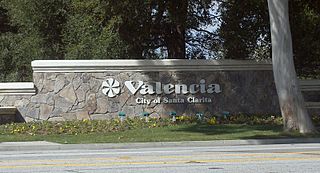
Valencia is a neighborhood in Santa Clarita located within Los Angeles County, California. It is the most populous of the four unincorporated communities that merged to create the city of Santa Clarita in 1987. It is situated in the western part of Santa Clarita, running from Newhall to the south to north of Copper Hill Drive. Valencia was founded as a master-planned community with the first development, Old Orchard I, built on Lyons Avenue behind the Old Orchard Elementary.
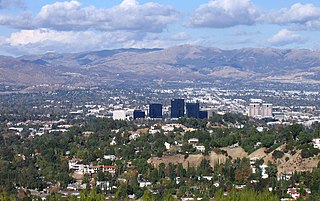
The Santa Susana Mountains are a transverse range of mountains in Southern California, north of the city of Los Angeles, in the United States. The range runs east-west, separating the San Fernando Valley and Simi Valley on its south from the Santa Clara River Valley to the north and the Santa Clarita Valley to the northeast. The Oxnard Plain is to the west of the Santa Susana Mountains.

The Santa Clara River is 83 mi (134 km) long, and is one of the most dynamic river systems in Southern California. The river drains parts of four ranges in the Transverse Ranges System north and northwest of Los Angeles, then flows west onto the Oxnard Plain and into the Santa Barbara Channel of the Pacific Ocean.
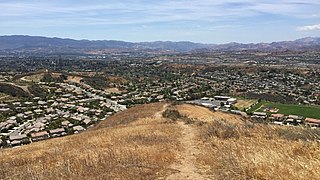
The Santa Clarita Valley (SCV) is part of the upper watershed of the Santa Clara River in Southern California. The valley was part of the 48,612-acre (19,673 ha) Rancho San Francisco Mexican land grant. Located in Los Angeles County, its main population center is the city of Santa Clarita which includes the communities of Canyon Country, Newhall, Saugus, and Valencia. Adjacent unincorporated communities include Castaic, Stevenson Ranch, Val Verde, and the master-planned community of FivePoint Valencia.

State Route 126 is a state highway in the U.S. state of California that serves Ventura and Los Angeles counties. The route runs from U.S. Route 101 in Ventura to Interstate 5 in Santa Clarita through the Santa Clara River Valley. The highway is an important connector highway in Ventura County, and serves as an alternate route into the Santa Clarita Valley, and the San Fernando Valley area of Los Angeles and the High Desert of Antelope Valley.
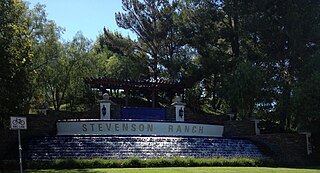
Stevenson Ranch is an unincorporated area in Los Angeles County, California. The community is located in the Santa Clarita Valley. Stevenson Ranch is set in the foothills of the Santa Susana Mountains and lies west of Interstate 5 and the city of Santa Clarita. Stevenson Ranch encompasses about 6.4 square miles (17 km2). About 1,000 acres (4.0 km2) are set aside as parks, recreation areas, and open space. A master-planned community, it was approved by the county in 1987. The population was 17,557 at the time of the 2010 census. For statistical purposes, the Census Bureau has designated it a census-designated place.

Newhall is the southernmost and oldest community of Santa Clarita, California. Prior to the 1987 consolidation of Canyon Country, Saugus, Newhall, Valencia and other neighboring communities into the city of Santa Clarita, it was an unincorporated area. It was the first permanent town in the Santa Clarita Valley.
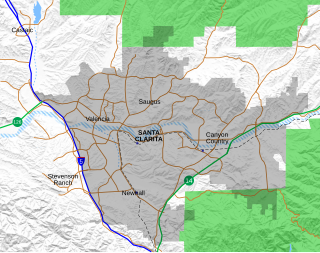
Canyon Country is a neighborhood in the eastern part of the city of Santa Clarita, in northwestern Los Angeles County, California, United States. It lies along the Santa Clara River between the Sierra Pelona Mountains and the San Gabriel Mountains.

The Santa Monica Mountains National Recreation Area is a United States national recreation area containing many individual parks and open space preserves, located primarily in the Santa Monica Mountains of Southern California. The SMMNRA is in the greater Los Angeles region, with two thirds of the parklands in northwest Los Angeles County, and the remaining third, including a Simi Hills extension, in southeastern Ventura County.

Saugus is a neighborhood in Santa Clarita, California. It was one of four communities that merged in 1987 to create the city of Santa Clarita. Saugus is named after Saugus, Massachusetts, the hometown of Henry Newhall, upon whose land the town was originally built.
The Newhall School District is a school district in the Santa Clarita Valley that serves the Valencia and Newhall communities within the city of Santa Clarita, California, as well as the Stevenson Ranch community in unincorporated Los Angeles County. As of March 1, 2008, it has 10 elementary schools. The superintendent is Jeff Pelzel.

Golden Oak Ranch is an 890-acre (360 ha) movie ranch owned by the Walt Disney Studios subsidiary of The Walt Disney Company that serves as a filming location and backlot. The ranch is off of Placerita Canyon Road outside of Newhall, Santa Clarita, California, less than an hour north of Los Angeles; its entrance is not far from Placerita Canyon Road's intersection with California State Route 14.
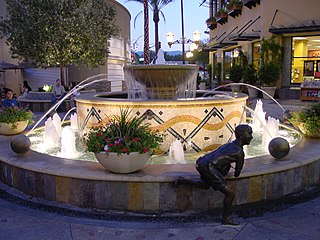
Santa Clarita is a city in northwestern Los Angeles County, California. With an estimated 2019 population of 212,979, it is the third-largest city by population in Los Angeles County, and the 21st-largest in the state of California. It is located about 30 miles (48 km) northwest of downtown Los Angeles, and occupies 70.75 square miles (183.2 km2) of land in the Santa Clarita Valley, along the Santa Clara River. It is a notable example of a U.S. edge city, satellite city, or boomburb.
City of Santa Clarita Transit is a local bus service, administered by the City's transit division, that serves the City of Santa Clarita, California and nearby surrounding unincorporated areas. Daily operations and maintenance of the fleet are under contract with MV Transportation. City of Santa Clarita Transit routes connect with services operated by Metro and Metrolink.

Rancho San Francisco was a land grant in present-day northwestern Los Angeles County and eastern Ventura County, California. It was a grant of 48,612 acres (19,673 ha) by Governor Juan B. Alvarado to Antonio del Valle, a Mexican army officer, in recognition for his service to Alta California. It is not related to the city of San Francisco.

Henry Mayo Newhall was an American businessman whose extensive land holdings became the Southern California communities of Newhall, Saugus and Valencia, and the city of Santa Clarita.

The Newhall Land and Farming Company is a land management company based in Valencia, Santa Clarita, California, United States. The company is responsible for the master community planning of Valencia and previously developed other areas such as Canyon Country and Newhall which together with Saugus and Valencia would merge to create the city of Santa Clarita in 1987. The company is also responsible for the management of farm land elsewhere in the state.
Litigation related to climate change and greenhouse gas (GHG) emissions has become increasingly common in federal and state courts. Following adoption of the Global Warming Solutions Act of 2006 and publication of the Intergovernmental Panel on Climate Change (IPCC) Fourth Assessment Report (AR4), additional pressure was placed on California public agencies to evaluate potential adverse effects to global climate change caused by GHG emissions. In particular, several lawsuits have been filed against agencies for failure to analyze GHG emissions generated by projects subject to the California Environmental Quality Act (CEQA). Court decisions prior to the 2010 revisions to the CEQA guidelines gave early insights as to how CEQA would be used as a vehicle to identify and mitigate GHG emissions within the state. Decisions issued after adoption of the revised guidelines are now being used to interpret CEQA's new requirement to evaluate GHG emissions and climate change.
Centennial, California is a proposed 12,323-acre (49.87 km2) master-planned community on Tejon Ranch, in Los Angeles County between Bakersfield and Los Angeles. It is situated in the far western Antelope Valley at the foothills of the Sierra Pelona and Tehachapi Mountains. The proposed community will be built along California State Route 138 east of Interstate 5 and northeast of Quail Lake.

Lang station is a former Southern Pacific railway station located in Soledad Canyon in Canyon Country, Santa Clarita, California. On September 5, 1876 the first railway to Los Angeles was completed at this site. The Lang Southern Pacific Station was designated a California Historic Landmark on May 22, 1957.
















